AUDIO: The Impact of Pandemic on Creativity, With Dr. James C. Kaufman
Table to Stage Podcast (James Kaufman interviewed)
Q&A: Doug Glanville Brings Major League Experience to UConn
UConn Today (Doug Glanville featured)
I Refuse to Run a Coronavirus Home School
The New York Times (Jennie Weiner pens op-ed about not recreating school for her children during the coronavirus)
Meet the Researcher: Clewiston Challenger, Educational Psychology

Editor’s Note: The following piece was originally published on UConn Today.
Clewiston Challenger never intended to be a researcher. When he was young, Challenger wanted to be a police officer. As an undergraduate at the University of Connecticut, he originally majored in biology with the aim of becoming a scientist.
Challenger, an alum of UConn’s Neag School educational psychology and clinical psychology programs, ultimately decided he wanted to work as a coach and school counselor since he had benefitted from having great mentors in those roles.
While working in urban communities in Hartford and New York City, Challenger saw first-hand the inequality of those school systems and the inertia toward improving them.
“I learned a lot, that school systems are unequal and it’s not for lack of trying,” Challenger says. “It’s just that there are some systems in place that are inefficient and changing them takes more work and money than leaving them as they are.”
Since returning to school and earning his Ph.D., Challenger has dedicated his career to studying how to improve how students of color and student-athletes of color adjust to college life particularly at predominantly white institutions (PWIs) through teaching them strategies that start at the high school level.
“I recognized that my experience as a student and my race and my gender all came together in how I experienced my academics and my campus climate.”
— Clewiston Challenger,
assistant professor of counselor education
Finding Community
Students of color at PWIs often lack a sense of belonging, since the people around their campuses often do not look like them.
Challenger has found that many students don’t realize how important their racial or cultural identity is to them until they are in an environment that doesn’t reflect it.
“As an undergraduate, I wasn’t fully attached to my African American roots. And then I came to a predominantly white university and it kind of slapped me in the face like, ‘there are a lot more people who are not like me than who are,’” Challenger says. “That was a big piece for me, because you can’t run from that, so that begins to take a toll.”
At historically black colleges and universities or Hispanic-serving institutions, issues of racial and cultural identity are woven into the curriculum and campus atmosphere, whereas at most PWIs, those topics are regarded as something students should work out for themselves. But when some students realize their racial, cultural, and ethnic identities are significant to them but are suddenly not reflected in their world, it can manifest as mental health issues. These issues can lead to low academic motivation, school involvement and poor social interactions.
Challenger has found that this sense of identity and need for community are key factors to an individual’s success in college.
“When a person feels a sense of community and a sense of self, then they can make a better assessment of who they are, what they need and who they want to become,” Challenger says.
In the Spotlight
As a student and student-athlete on the UConn football team, Challenger became aware of the ways in which his identities impacted his experience.
“I recognized that my experience as a student and my race and my gender all came together in how I experienced my academics and my campus climate,” Challenger says. “So I thought it was kind of cool to see if other people felt the same way about their academic experience.”
Student-athletes of color can face unique challenges in college because they are on a much more public stage than the average student. Most of these athletes often feel pressure to not only represent their school and their athletic program, but their race and culture as well.
Being on this kind of stage increases pressure for students, which can cause or manifest mental health issues. The deeply ingrained stigma surrounding mental health as it pertains to student-athletes can be detrimental to their overall wellbeing and their academic and athletic performance.
Challenger has dedicated his career to studying how to improve how students of color and student-athletes of color adjust to college life, particularly at predominantly white institutions.
“It’s still taboo,” Challenger says. “Players are struggling with mental health issues on their own predominantly because athletes, male or female, are seen as warriors. They’re seen as Olympic-sized people, gladiators even. They’re not supposed to get sick or have issues with fear and adversity. And athletes take those external perceptions in deeply.”
Removing the stigma and having frequent, honest conversations about mental health can help student athletes access the resources they need before it becomes a crisis.
“The problem is the help usually comes when it’s at the most extreme,” Challenger says. “Now you’re taking extreme measures to save the person’s life or career when you’d rather catch the symptoms early. It’s like saying, ‘when my leg falls off then I’ll see a doctor.’”
Many schools with varsity sports have robust and comprehensive strength and conditioning, nutrition, and academic success programs. Mental health and wellness awareness and support should be part of that programming format as well, according to Challenger.
Building the Plane While Flying It
One factor Challenger looks at to determine how a student may adjust to college is their level of self-efficacy, the idea that they are able to accomplish goals and handle setbacks. If a student enters college with low self-efficacy, they will probably have a harder time making friends, getting involved and succeeding academically. Students with high self-efficacy will likely be more positively adjusted to college life.
One of the biggest pushes for Challenger’s work is to begin preparing students with the support they will need for college while they are still in high school. By determining a student’s level of self-efficacy, counselors in high school can work to maintain or increase their sense of self-efficacy before they get to college.
Challenger is currently launching a pilot program called the College Transition Program for Student Athletes (CTPSA) at a local high school as part of his research. The program will have eight sessions dealing with different topics student-athletes should understand before entering college, including navigating residential life, understanding the NCAA recruiting process and policies, acquiring financial literacy, choosing a major, and developing racial identity.
“Currently, when student-athletes enter college, they’re building the plane while flying it,” Challenger says. “Though student-athletes will go through tough adjustment times regardless, the goal of the CTPSA program is to maybe help them make better decisions or more informed decisions after being part of it.”
Challenger hopes to continue to develop this program into a “one-stop shop” for students where they can get help with test prep, mentoring, the admissions process and college tours.
Coming Back to UConn
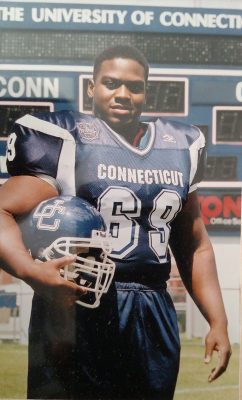
When Challenger received his Ph.D. from Pennsylvania State University in 2017, he intended to work as a professor at an urban college and train future school counselors who wanted to work in urban schools. But when his former mentor — now a colleague — told him how UConn’s school counseling program had changed its model to focus on urban counseling and social justice, he applied for a faculty position.
“Students at UConn might need my experience more than students in Queens,” Challenger says. “I came back to UConn to be part of that that team, to be part of that vision, to be a part of that design, and that’s really inspired me.”
When counselors only have their own background to rely on, they often have a hard time working effectively with students and families of color. This can lead to frustration on both ends.
“That’s the reason why there’s a drain of good talent that doesn’t stay in urban education,” Challenger says. “New counselors often feel that urban schools are facing big problems. Many try to make an impact, and some are effective, some are not immediately effective, and many quickly give up or even leave the school if they feel ineffective working with urban students.”
For counselors and educators in urban communities to help students expand their horizons, they need to be trained to work with students of color who come from backgrounds different than their own, especially since schools everywhere are becoming more diverse.
“Students who attend typical school counseling programs that don’t harp on these multicultural issues and changes in school diversity are not adequately preparing school counselors for the reality they’ll face in the professional world,” Challenger says.
In addition to being well-trained counselors, Challenger encourages his students to be activists and advocates.
“Most times legislators make legislation about education without educators at the table,” Challenger says. “The counselors are often stuck enforcing regulations that don’t help or create academic achievement. We need school mental health professionals to represent the holistic component of students and families in the policymaking process.”
Putting it Together
In his research, Challenger believes we should treat students as whole people, rather than considering their academics, athletic performance, mental health, and social adjustment separately.
“I’m always surprised that people often do not make the connection. People don’t put it all together. They leave each aspect in isolation, addressing them separately, not intersectionally,” Challenger says. “And I think that’s either my skill, or that’s the way I think, is that they all do interconnect to address the person holistically.”
Challenger describes his role as a researcher as being similar to an entrepreneur. Research is not just about having great ideas, but having the tenacity and enterprise to get those ideas off the ground.
“That’s the toughest thing about research,” Challenger says. “You can have all the ideas in the world, but if you don’t have the funding, if you don’t have the motivation, if you don’t have the team, these are some challenges you can face in an effort to be effective. It’s a marathon more than a sprint.”
Follow UConn Research on Twitter and LinkedIn.
Two Districts, Two Very Different Plans for Students
CT Mirror (Sarah Woulfin and Michael Young quoted)
Guidance for Parents, Students, Educators Amid School Closures

As school closures are announced across the state and country, the Neag School looked to its resident experts to provide guidance and insights for students, parents, educators, and administrators.
Here’s what they had to say:
1. What are some helpful tips for educators in managing their lessons during the school closures?
Morgaen Donaldson, associate professor of educational leadership and director of the Center for Education Policy Analysis: This is a good opportunity to follow the adage of “less is more.” What is most essential that students [need to] learn? What can show you (and them) that they’ve learned this skill
Michael Young, associate professor of educational psychology and coordinator of the Educational Technology program: Be thoughtful and don’t just put classroom lessons online. Consider the advantages of online learning (personalized, adaptive, nonlinear) and revise your classroom lesson for online interactions. Former Neag School professor Don Leu’s research found that there are new reading and writing literacies associated with online learning. We don’t write the five-paragraph essay as a response to a teacher blog, and we don’t read from page one through page 10 on the internet. These new literacies can be nurtured with online learning, but must be supported and understood by teachers.
“Follow your child’s interests and energy levels. Reading, talking, and writing about their interests is invaluable.”
— Sarah Woulfin, associate professor
2. How can educators keep their connections going with the students?
MD: This is a great question that I know is on the minds of many, many educators. I have seen educators use technology to connect with students, but it’s important to remember that not all students have access to the internet or computers. Apps can help in this regard, since many parents (and some children) have phones. A letter in the mail is also a good option. A connection makes a huge difference to students of all ages, and to educators as well.
Sarah Woulfin, associate professor of educational leadership: Educators could write/email letters and updates related to students and families.
3. If educators are unfamiliar with teaching online, how can they get up to speed and become more comfortable in making the most of this space for their students?
MY: Online teaching and learning are different from classroom whole-class and group instruction. Optimally, online learning requires greater prep time and less teacher interaction at the time of instruction delivery. Those with experiences with Flipped classroom, screencasting, or use of tools like Zoom, Webex, or Blackboard Collaborate will be able to be in touch with whole groups for live, synchronous interactions. But teachers must also be ready to create something more than worksheets for students to explore and interrogate content on their own.
Realize the following:
- Much online learning relies on students to organize their own learning time, learning spaces, and work routines (this is called self-regulation in the research literature). These are things teachers can teach and scaffold for students.
- Teaching online is different from teaching face-to-face. Online teaching relies heavily on the analytics collected by the learning management system (including when students log in, how long they stay on particular pages, and the contributions they make in various course areas). This is roughly the substitute for watching student behaviors in class.
- Students will need help differentiating how to use the computer for entertainment and how it should be used for learning as part of school. Often, the rules for how students treat each other online and how they interact may need to be modified from the entertainment realm to the in-school realm.
- Online (web-based), Digital (such as voice over IP or video conferencing like Skype, Facetime, Webex, Zoom, or Collaborate) and Virtual (such as meeting students in Mindscape or other avatar-based virtual worlds) are all possibilities for connecting with students away from classrooms.
- Beyond devices and data plans, students may also need to organize their actual home spaces for learning, including headsets and closed areas that do not interfere with parents trying to work at home, or other children also trying to learn.
Teacher preparation is key to success. Teachers who are already using tools like SeeSaw to communicate, or are fluent with video production, can leverage those skills to create meaningful learning experiences for their students.
4. For educators, what are some useful tools for online student learning?
MD: For K-12 educators in upper elementary through high school, Khan Academy is an excellent resource. There are numerous other websites that are great — BrainPop and Epic! are two that come to mind. Most libraries also provide online access to books and audiobooks and other resources that people can download. I read that New York City Public Library is allowing free access to all of its titles through Simply E. This will help kids (and adults) keep their minds engaged while out of school.
5. With parents in many cases now overseeing their children’s education at home, what is one piece of advice you can share with them?
SW: Follow your child’s interests and energy levels. Reading, talking, and writing about their interests is invaluable. Family conversations and reflections also play a role in teaching social emotional skills. School entails more than math, reading, and writing, so consider activities related to art, music, physical education, and science (nature and weather).
6. If students have limited or no access to the internet for online learning, what are some alternatives?
MY: Typically, this would include public libraries and other after-school learning places (like YMCA, boys clubs, etc.) It remains to be seen how restricted these activities may be for a while. Working with one other student who does have access may be an alternative to consider.
“It’s important to remember that everyone is dealing with significant stress and uncertainty at home. Teachers and staff are likely worried about their own families and loved ones.”
— Michael Young, associate professor
7. How can parents best organize the day with students at home?
MD: Try to make the day as “normal” as possible by keeping up routines like getting up and going to bed at regular times, having meals together, doing regular things like brushing teeth, making beds, and doing daily chores. Then have a structure for their learning activities — whether it’s a certain amount of work or a certain amount of time on each activity, and giving them choices about what to learn, how to learn, and when. Get them outside to burn off steam! Exercise — whether dancing, running, playing basketball, doing yoga, doing sit-ups and push-ups — is essential.
8. What are some possible impacts if schools do not reopen this spring?
MD: Nothing like this has happened in the modern era, so it’s hard to tell what the impact will be. I expect the impact will vary by the length of time lost. It may also vary by the age of the child. Unfortunately, it may also vary by the resources of the family.
9. If a school/district isn’t online, how can they accommodate the current situation?
MD: Teachers and administrators are working really hard to make resources available to all families, on- and off-line.
10. For lab courses, what can educators do to keep their students learning?
MY: For activities that have virtual lab equivalents (like the Virtual Frog), substitutions may be easy. For others, videotaped demonstration may have to substitute in the short run for actual hands-on experiences.
11. How can school administrators keep their staff motivated during this time?
MD: This is a great question. It’s important to remember that everyone is dealing with significant stress and uncertainty at home. Teachers and staff are likely worried about their own families and loved ones. They are also distraught by their inability to care for and work with the students with whom they have developed a bond over the past year (or more).
Administrators should stay in contact with their staff and check in on their well-being first and foremost. If staff and their families are well, administrators could encourage them to work together virtually to plan how to support their students’ learning. This is an opportunity for grade-level teams and subject-area teacher teams to work with their teammates to develop common goals and activities. They can also support each other through this trying time.
SW: Leaders can offer support and care during this period, encouraging wellness and encouraging others to maintain balance and to navigate this period with grace.
Neag School Accolades: Spring 2020
Congratulations to our Neag School alumni, faculty, staff, and students on their continued accomplishments inside and outside the classroom. If you have an accolade to share, we want to hear from you! Please send any news items and story ideas to neag-communications@uconn.edu.
In addition to the Dean’s Office and Department achievements, explore this edition’s list for Accolades from Faculty/Staff; Alumni; and Students; as well as In Memoriam.
Dean’s Office and Departments
U.S. News & World Report has issued its 2021 rankings of the best graduate schools of education in the nation, with the Neag School ranking among the top 20 public graduate schools of education in the United States for the fifth consecutive year. In addition, two of the Neag School’s specialty programs now place among the top 25 in the United States: Special Education (No. 12) and Elementary Teacher Education (tied at No. 25).
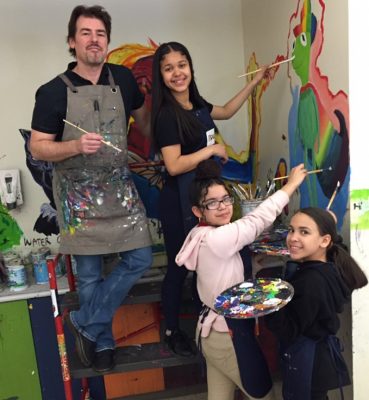
Jason Gilmore of Guilford, Conn., an art teacher at Hartford’s McDonough Middle School, has been named by the Neag School as the recipient of the 2020 Rogers Educational Innovation Fund award, which provides $5,000 to an elementary or middle-school level teacher in Connecticut for use toward an innovative classroom project. Read more about Gilmore’s winning project.
Department of Curriculum and Instruction (EDCI) and Teacher Education
The Department of Curriculum and Instruction recently updated its website, which now includes recent department news, research highlights, and upcoming events.
Dominique Battle-Lawson represented the Neag School at the American Association of Colleges for Teacher Education (AACTE)’s annual conference in Atlanta, Ga., in February; she gave a presentation about the Neag School’s collaboration with other institutions on recruiting Black and Latino men into university teacher education programs.
U.S. News & World Report has issued its 2021 rankings of the best graduate schools of education in the nation, including its rankings for specialty programs, with the Neag School’s program in the Elementary Teacher Education category tied at No. 25.
Department of Educational Leadership (EDLR)
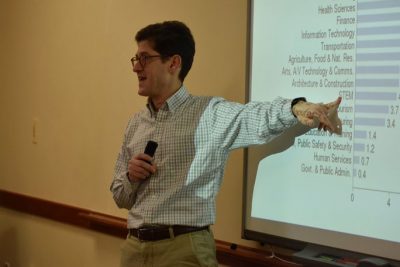
The Center for Education Policy Analysis (CEPA) co-hosted a Speaker Series on the UConn Storrs campus in March featuring Brian Jacob, Walter H. Annenberg Professor of Education Policy and Professor of Economics at the University of Michigan. Jacob shared insights about the demand for and effects of high school career and technical education. The event was co-sponsored by the Philip E. Austin Chair, the Center for Economic Policy and Analysis, and the Department of Economics. View photos from Jacob’s talk.
Students in sport management hosted the fourth annual Sports Business Conference, featuring such speakers as Taylor Kielpinski-Rogers, director of communications at the NFL, and Ari Borod, chief commercial officer at the Action Network. The full-day event, held on the UConn Storrs campus in January, featured workshops, networking, and panel discussions. Mentors from a multitude of companies led students through case studies. Check out photos from the student-led conference.
The sport management program hosted a visit from UConn alum Billy Haubrich, senior manager of learning and development for business operations at Disney; and Brent Colborne ’05 (BUS), director of programming and acquisitions at ESPN, who facilitated a workshop, “Building Your Personal Brand,” for current sport management undergraduate students.
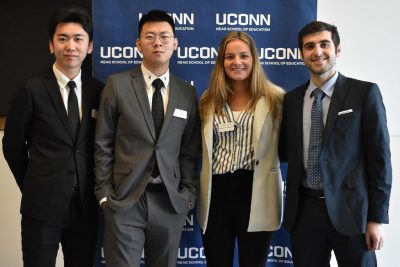
Department of Educational Psychology (EPSY)
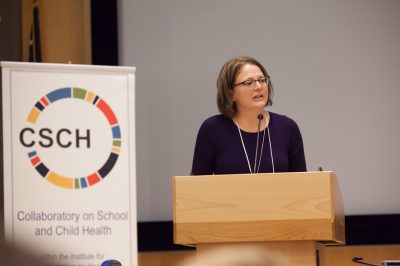
The Department of Educational Psychology recently updated its website, which now includes recent department news and upcoming events.
A research project led by UConn’s Collaboratory on School and Child Health (CSCH) known as the National Exploration of Emotional/Behavioral Detection in School Screening, or the NEEDs² Project, was featured in UConn Today. The project team includes alumna Amy Briesch ’05 MA, ’09 Ph.D., ’09 MA, ’09 6thYear, co-principal investigator from Northeastern University; Betsy McCoach, co-principal investigator; Jennifer Necci Dineen, from UConn’s Department of Public Policy; and Helene Marcy, from the Collaboratory on School and Child Health. CSCH is co-directed by Sandra Chafouleas.
U.S. News & World Report has issued its 2021 rankings of the best graduate schools of education in the nation, including its rankings for specialty programs, with the Neag School’s program in Special Education ranked at No. 12 in the country.
Faculty/Staff
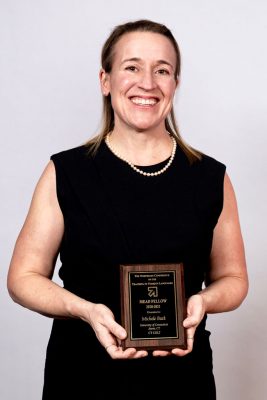
Michele Back was awarded a 2020 Northeast Conference on the Teaching of Foreign Languages (NECTFL) Mead Leadership Fellow. This award provides support for the development of a project contributing to the foreign language teaching profession and advancing quality language instruction. She was recognized at the NECTFL Awards Ceremony in February in New York, N.Y.
Todd Campbell co-published with Neag School alumnus Thomas J. McKenna ’18 Ph.D. and curriculum and instruction doctoral student Laura Rodriguez, along with another colleague, “A Responsive Methodological Construct for Supporting Learners’ Developing Modeling Competence in Modeling-Based Learning Environments” a chapter in Models and Modeling in Science Education series (Springer, 2019). Campbell also co-published “Developing and Supporting the Next Generation Science Standards: The Role of Policy Entrepreneurs” for the January issue of Science Education Policy and “3D Interim Assessments Guided by Coherence, Shared Models of Learning, and Attention to Equity” for the January issue of STEM Teaching Tools. He also co-presented with doctoral students Byung Park and Laura Rodriguez ’16 (ED), ’17 MA, along with David Moss and postdoctoral researcher Lisa Lundgren at the 2020 Association for Science Teachers Education (ASTE) International Convention in San Antonio, Texas, in January.
Milagros Castillo-Montoya has been working with doctoral students Jillian Ives and Joshua Abreu on publishing faculty profiles for the “People in the Reform” Project funded by Strong Start to Finish, a network supported by the Education Commission for the States. The profiles included education experts Milena Cuellar, Sarah F. McGinley, Jeremiah Pitts, and Brenda Oursler White. Castillo-Montoya and Ives’ recent article “First-Generation College Students as Academic Learners: A Systematic Review” also was featured by the Center for First-Generation Student Success. In addition, Castillo-Montoya has been selected to be part of the University of Michigan Diversity Scholars Network, a distinguished international research community focused on using scholarship to advance social transformation.
Casey Cobb published “Geospatial Analysis: A New Window Into Educational Equity, Access, and Opportunity” for the February issue of Review of Research in Education, and book chapter “Droppin’ the Mic: Framing the Implications of Policy-Relevant Research for Maximum Impact” for the forthcoming Maximizing the Policy-Relevance of Research for School Improvement. In addition, he co-authored a chapter titled “Private Interests and the Common Good: Conflicting Priorities in a School Choice World” with Jason Irizarry in Handbook on Promoting Social Justice in Education (Springer, 2020). Cobb also has been named the 2020 UConn-AAUP Service Excellence Award by University of Connecticut’s chapter of the American Association of University Professors. He will be formally recognized at a ceremony in April at the State Capitol Building in Hartford, Conn.
Rachael Gabriel’s papers “Running Records: A Quick and “Surprisingly Fruitful” Diagnostic Tool” from The Reading Teacher and “Three Questions School Leaders Might Ask About Literacy Instruction” from Educational Leadership were featured in Marshall Memo.

Doug Glanville wrote a commentary for the New York Times about the baseball cheating scandal.
Richard Gonzales hosted a webinar titled “Lessons Learned by ReDesign: Assessing Candidate Outcomes in UConn’s Administrator Preparation Program” for the National Association of Secondary School Principals in March.
Robin Grenier, along with doctoral student Kristi Kaeppel and two colleagues, presented a paper at the Academy of Human Resource Development’s (AHRD) 2020 Conference in the Americas in Atlanta, Ga., in February.
Robin Hands co-published “Daring Greatly: School-University Partnerships and the Development of Teacher Leadership” with alum June Cahill ’92 (CLAS) ’93 (ED), ’94 MA and former faculty member René Roselle in a special 2020 themed issue of the National Association for Professional Development Schools’ School-University Partnerships journal.
James Kaufman co-published “The Creative Student in the Eyes of a Teacher: A Cross Cultural Study” for the January issue of Thinking Skills and Creativity; “The Development of Mathematical Creativity Across High School: Increasing, Decreasing, or Both?” for the February issue of Thinking Skills and Creativity; and “The Assessment of Creative and Innovative Performance” for the November issue of Creativity and Innovation in Organizations.
Allison Lombardi co-hosted a webinar titled “How Do You Know Students Are College and Career Ready?” for the National Technical Assistance Center on Transition in February.
 Devin Kearns co-presented three sessions at the Council for Exceptional Children’s annual conference in Portland, Ore., in February. He also co-published “Using Information-Theoretic Measures to Characterize the Structure of the Writing System: The Case of the Orthographic-Phonological Regularities in English” for the January issue of Behavior Research Methods.
Devin Kearns co-presented three sessions at the Council for Exceptional Children’s annual conference in Portland, Ore., in February. He also co-published “Using Information-Theoretic Measures to Characterize the Structure of the Writing System: The Case of the Orthographic-Phonological Regularities in English” for the January issue of Behavior Research Methods.
Gladis Kersaint co-published with Rebecca Campbell-Montalvo and Hesborn Wao, a doctoral student in curriculum and instruction, along with other colleagues, “Pursuing an Engineering Major: Social Capital of Women and Underrepresented Minorities” for the 2020 issue of Studies in Higher Education.
Lisa Lundgren, a postdoctoral research associate, co-published “Social Media Interaction as Information Science Learning: a Comparison of Message Design in Two Niches” for the January issue of Research in Science Education.
Jennie McGarry has been selected the University of Illinois Distinguished Speaker for the College of Applied Health Sciences Distinguished Lecture Series.
Natalie Olinghouse, along with educational psychology doctoral student Sally Valentino Drew, and another colleague, co-published “Reconceptualizing Instruction for Writing in Science Using the WiS Planning Tool” for the January issue of Teaching Exceptional Children.
UConn’s BOLD Women’s Leadership Network, led by Sally Reis, has been re-funded for another two years for $1.2 million by the Helen Gurley Brown’s Pussycat Foundation.
Lisa Sanetti co-wrote with Hao-Jan Luh, a doctoral student in special education, a chapter titled “Treatment Fidelity in School-Based Intervention” in Student Engagement (Springer, 2020). Sanetti also co-published “Treatment Integrity of Intervention Studies in Professional School Counseling From 1997 to 2018: A Systematic Review” in the March issue of Professional School Counseling.
Del Siegle, alumna Lisa Davia Rubenstein ’07 MA, ’11 Ph.D., and D. Betsy McCoach co-published “Do You Know What I’m Thinking? A Comparison of Teacher and Parent Perspectives of Underachieving Gifted Students’ Attitudes” for the January issue of Psychology in the Schools. Siegle also gave a keynote and two conference presentations at the Whitworth University Breaking Barrier: Understanding and Responding to Diversity in Student Potential Conference in Spokane, Wash., in February. Also last month, he gave a keynote and two conference presentations at the 46th Annual Arizona Association for Gifted and Talented Annual Conference in Phoenix, Az., and a keynote and two conference presentations at the Illinois Association for Gifted Children Conference in Chicago, Ill. In addition, he penned a blog post about gifted students for Gifted Assessment Insights.
Brandi Simonsen co-published with retired faculty member George Sugai “Reinforcement Foundations of a Function-Based Behavioral Approach for Students With Challenging Behavior” for the January issue of Beyond Behavior.
Brandi Simonsen, Jennifer Freeman, alumna Kathryn Dooley ’17 Ph.D, alumna Laura Kern ’11 MA, ’17 Ph.D., and doctoral student Sang Byun ’13 MA, along with another author, co-wrote “The Effects of Targeted Professional Development on Teachers’ Use of Empirically Supported Classroom Management Practices” for the 2020 issue of Journal of Positive Behavior Interventions.
Megan Staples co-published “Justification as an Equity Practice” for the February issue of Mathematics Teacher: Learning & Teaching PK-12.
Violet Jiménez Sims wrote a commentary for CT Mirror about eliminating teacher performance assessment (edTPA) for students in teacher training.
Jaci VanHeest was profiled by UConn’s Collaboratory on School and Child Health (CSCH).
Jennie Weiner published “From New to Nuanced: (Re)Considering Educator Professionalism and its Impacts” for the February issue of the Journal of Educational Change.
Sarah Woulfin was awarded the American Education Research Association’s Districts in Research & Reform SIG-Outstanding Publication Award for her article “Mediating Instructional Reform: An Examination of the Relationship Between District Policy and Instructional Coaching,” originally published in AERA Open.
Students
Joshua Abreu, a doctoral student in educational leadership, was selected as one of 10 new cohort members of UConn Graduate School’s Dr. Radenka Maric Graduate Fellowship. Through this fellowship, Abreu received a stipend and has the opportunity to network with 10 other graduate students at UConn and attend professional development workshops. Abreu also co-wrote a book chapter in Student Engagement in Higher Education: Theoretical Perspectives and Practical Approaches for Diverse Populations (Routledge, 2019).
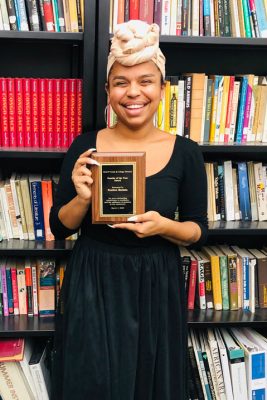
Pauline Batista ’16 MA, a doctoral student in educational leadership, was recognized by UConn’s NAACP Youth & College Division with the Faculty of the Year Award for her commitment to excellence. She also accepted a full-time job as a program specialist at her graduate assistant site, the UConn African American Cultural Center.
Batouly Camara ’19 (ED), ’20 MA, a sport management master’s student and current UConn women’s basketball team player, was featured in a UConn Magazine Q&A.
Robert Cotto, doctoral student in educational leadership, presented at Race and Identity Matters Initiative, a one-day symposium on the UConn Storrs campus in February. He also was interviewed last month by WSHU Public Radio (24:56) about the ongoing movement around opting out of standardized tests, in addition to co-publishing “The Under-funding of Latinx-serving School Districts” for the February issue of Phi Delta Kappan.
Joseph Galarza, a higher education and student affairs graduate student, wrote an op-ed for the Hartford Courant about the need for international students to engage.
Emily Iovino ’15 (ED), ’16 MA, a doctoral student in educational psychology, co-wrote with Sandra Chafouleas, Amy Briesch ’05 MA, ’09 Ph.D., and another colleague “Exploring the Alignment of Behavior Screening Policies and Practices in US Public School Districts” for the January issue of Journal of School Health.
Jillian Ives, doctoral student in educational leadership, along with Milagros Castillo-Montoya, co-published “First-Generation College Students as Academic Learners: A Systematic Review” for the January issue of Review of Educational Research. Ives was also recently awarded the Jim Rhatigan Fellowship Scholarship from the Student Affairs Administrators in Higher Education (NASPA), which will support her attendance at the national conference in March, in Austin, Texas; she also has been appointed to the new professional and graduate student review board of the Journal of Student Affairs Research and Practice.
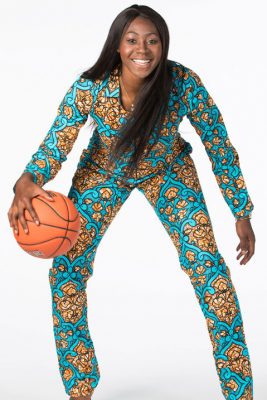
Susan (Meabh) Kelly, doctoral student in curriculum instruction, has been elected National Science Teacher Association’s District I director for Connecticut, Massachusetts, and Rhode Island.
Ian McGregor, doctoral student in curriculum and instruction, along with Alan Marcus and David Moss, co-published “Promoting Intercultural Competence in Professional Spaces: Educational Abroad Experience in England for Social Studies Pre-Service Teachers” for the January issue of Promoting Intercultural Competence in Professional Spaces.
Jessica Monahan ’09 (ED), ’09 MA, doctoral student in educational psychology, co-published with Allison Lombardi, Joseph Madaus, Jennifer Freeman, and alums Sarah R. Carlson ’12 (ED), ’13 MA and Nicholas Gelbar ’06 (CLAS), ’07 MA, ’12 6th Year, ’13 Ph.D. “A Systematic Literature Review of College and Career Readiness Frameworks for Students with Disabilities” for the February issue of Journal of Disability Policy Studies.
Thienly Nguyen ’20 MA, a student in the Teacher Certification Program for College Graduates, has been named the NASA Connecticut Space Grant Consortium (CSGC) Outreaching Graduate Fellow. She will be working with the CSGC as a grants office liaison this spring, connecting their office with in-state K-12 schools and other education institutions (e.g., museums) to support STEAM education programs for students and their teachers.
Ashley Robinson, doctoral student in educational leadership, has been appointed to the editorial board for the Journal of Critical Scholarship in Higher Education and Student Affairs (JCSHESA). Robinson has also been awarded the College Student Educators International (ACPA) 2020 Distinguished Commission Directorate Member Award in recognition of her work with the ACPA Commission for Housing and Residential Life.
Dakota Cintron, Jocelyn Perez, and Jennifer Richardson, doctoral students in educational psychology, have been awarded National Council on Measurement in Education (NCME) Fellowship for underrepresented professionals in educational measurement. Fellows will receive funding for travel to attend the annual meeting, free registration for pre-conference workshops, free NCME conference registration, a series of professional development activities designed to support them in building a successful trajectory in the educational measurement field, and access to a network of colleagues and mentors within the field.
Alumni

Charles D. Britton ’07 Ph.D. has been selected superintendent of schools for Portland (Conn.) Public Schools. Britton, an educator for the past 25 years, currently is the school system’s director of curriculum, instruction, and technology.
June Cahill ’92 (CLAS), ’93 (ED), ’94 MA, the principal at Kennelly School in Hartford, Conn., was featured by Fox61, along with fellow educators at the school, for their fun way of reaching students during the COVIS-19 outbreak.
Miguel Cardona ’01 MA, ’04 6th Year, ’11 Ed.D., ’12 ELP, is featured by CT Mirror about his role as the Connecticut education commissioner.
Melissa Collier-Meek ’08 (CLAS), ’09 MA, ’11 6th Year, ’13 Ph.D. and Lisa Sanetti co-presented at the annual convention for the National Association of School Psychologists (NASP) in Baltimore, Md., in February.
Michael C. Crawford ’14 MA has been appointed director of diversity and inclusion for the College of Our Lady of the Elms, in Chicopee, Mass. Most recently, he was a research associate in a culture and mental health disparities lab at the University of Connecticut.
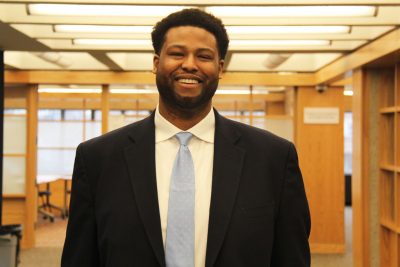
Neag School alums and current and former UConn women’s basketball team coaches Chris Dailey ’99 MA, Jamelle Elliott ’96 (BUS), ’98 MA, and Shea Ralph ’02 (ED) were featured in UConn Magazine’s Winter issue.
Jennifer Dolan ’17 Ph.D. wrote an original commentary for the Hartford Courant about how Native American mascots condone racism.
Gara Field ’07 Ph.D. brought her students from Moses Brown School in Providence, R.I., for a visit to the UConn Storrs campus in February. Field is a former Husky Sport graduate assistant who helped develop the curriculum for EDLR 3547: Introduction to Sport-Based Youth Development. She is director of global education and social innovation at Moses Brown and is teaching a mini-course with young girls entitled HERstory: Women, Sports & Society.
Robert “Bob” Garry ’05 6th Year, principal at Hatton Elementary School in Southington, Conn., was featured by NBC Connecticut for his initiative on making positive phone calls to family members of students.
Wally Lamb ’72 (CLAS), ’77 MA had his 1998 novel “I Know This Much is True” turned into an eight-episode HBO miniseries.
Bryan Olkowski ’05 6th Year, ’15 ELP, has been selected superintendent of Washington Central Unified School District in East Montpelier, Vt. He is currently the principal at Torrington (Conn.) Middle School.
Leah Osborn ’19 Ph.D. and Robin Grenier presented a paper at the Academy of Human Resource Development’s (AHRD) 2020 Conference in the Americas in Atlanta, Ga., in February.
Tony Pulino ’69 (ED) was inducted into the Middletown (Conn.) Hall of Fame for track. Pulino was among the top cross-country and one-mile runners on the Connecticut high school scene in the early 1960s and competed at UConn in track and cross-country from 1965 to 1967.
Louise Spear-Swerling ’76 (CLAS), Yan Wei ’11 MA, ’15 Ph.D., Hannah Dostal, and doctoral student Brittney Hernandez, co-published “The Print Exposure of Teacher Candidates in Relation to Their Achievement and Self-ratings of Early Reading Experiences” for the March issue of Reading and Writing.
In Memoriam
David L. Boivin ’54
James B. Caulfield ’61
Andrea R. Cooley ’68
Barbara L. Campbell ’77
Richard R. Crockett ’63
Linda C. Dickson ’79
George G. Dunn ’68
Charles E. Funk III ’60
John S. Gray Jr. ’77
Anne C. Holzer ’78
Loisann B. Huntley ’86
James F. LeClaire ’56
Jeffrey K. Moeckel ’74
Terry W. Neu ’93
Andrew J. Nicholas II ’90
Virginia T. Palmer ’92
Eugene F. Phaneuf ’67
Carol K. Phillips ’73
Constance B. Pratt ’84
Robert E. Pratt ’75
Maxine R. Schortman ’67
Brian D. Sherman ’74
Dorothy B. Spaulding ’74
Laura A. Stasaitis ’72
Germaine L. Welch ’77
Meet the Researcher: Clewiston Challenger, Educational Psychology
UConn Today (Clewiston Challenger featured)
